
In 2015, some jag-off stole my Cocotte. I was absolutely despondent. I barely cared about my $1,200 laptop even though I didn’t have the money to replace it. I didn’t care about the precious data on it. I didn’t even think about the tools, keys, and miscellaneous irreplaceable goodies hidden in its pockets.
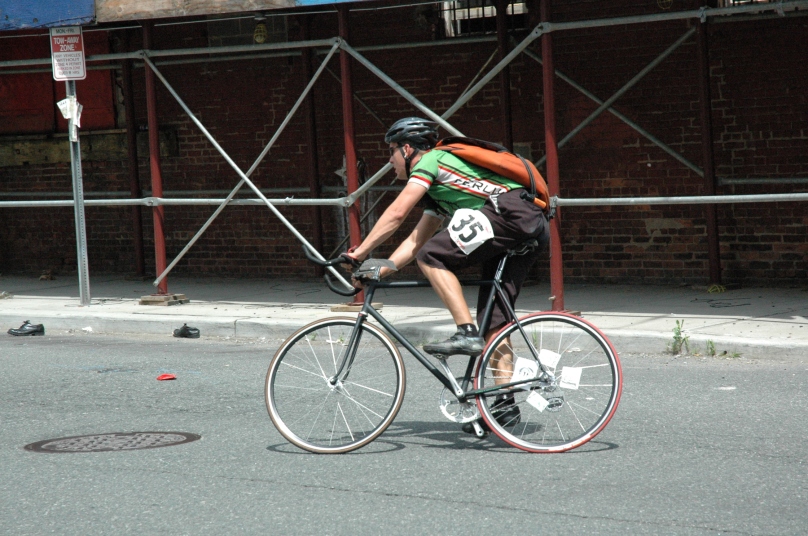
My heart was broken that someone had stolen that dirty, stained, smelly, torn, 16-year old messenger bag that had never seen the inside of a washing machine. I won it in 1999 at the Toronto North American Championships, but more importantly it was the best damn bag I’d ever owned. Being pretty booby, finding a strap that worked with my frame was impossible. It was cushioned in all the right spots, held its form when you put it on a flat surface, was easy to sort envelopes and best of all, it could crunch neatly into low-profile bag, or expand to accommodate a case of beer, a 10-lb. bag of cat food and a 20 lb. of kitty litter. That bag earned me money in Washington, DC, New York City, and Toronto. She was there at the end of my messenger career and just by looking at her patches, I could go back in time to happy places and exciting friends. The “messenger” bag, in its current mass-produced incarnation, would disintegrate with the rigors of my old messenger life. Now it is an ubiquitous thing. So much so, in fact, the “messenger” in messenger bag is merely an identifier, and has little to do with its original purpose.

To many of us the former and current messengers, there is an important distinction that needs to be made. Messenger bags were designed with a purpose, and a culture in mind. The creation, evolution and spread of the messenger bag is two parts legend and one part verifiable facts. Much like the book I wrote, Nerves of Steel: Bike messengers in the United States, these important histories sometimes need to be captured without prejudice so the reader can sort through and find the consistencies in these oral traditions to determine the truth.
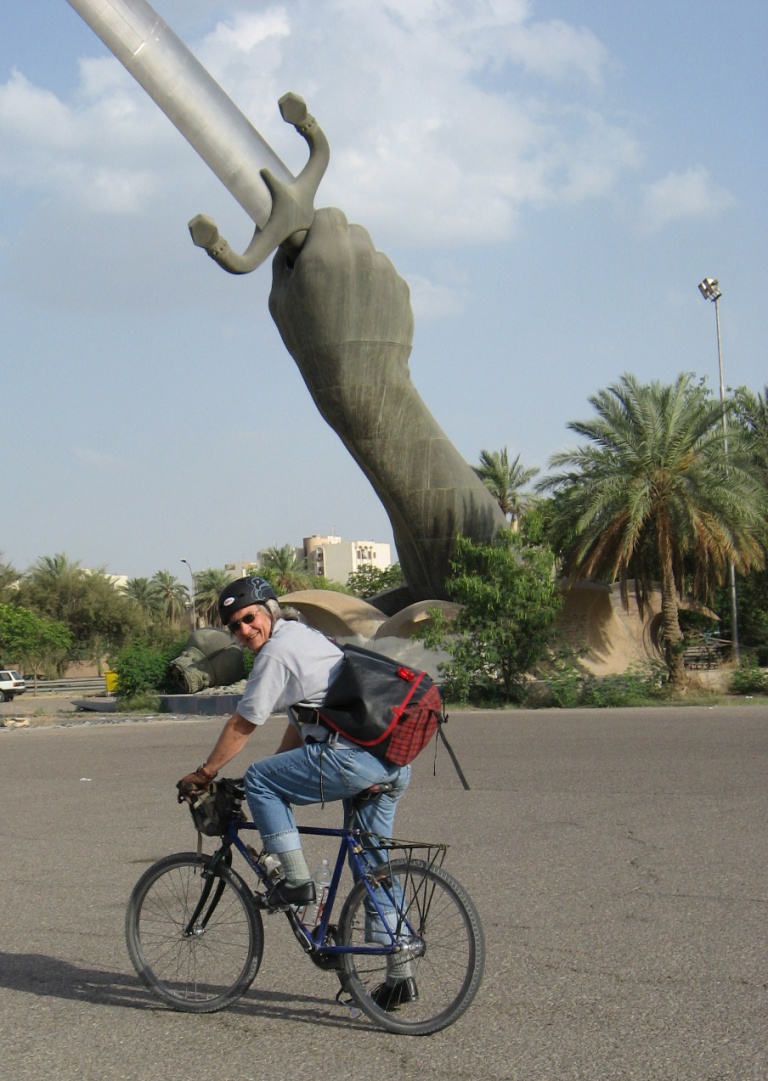
When I first published Nerves of Steel, I had a fair amount of non-messenger buyers, one was Roy Caldwell, a non-messenger who found our culture particularly fascinating. Over the years, we’ve exchanged pleasant emails and recently he told me of a historical research project about messenger bags he’d been working on. Though it is too long for publishing on this platform, I would like to include some of it in this joint blog. I’ve taken some of his facts and personal depictions and added some context to the mise en scène from my own personal experience, interviews and research. I have also included some oral history from some of the bag makers and messengers who were influential when I was a courier.

If I have omitted or misrepresented information, I apologize. It seems however, after a Facebook thread was shared about the subject, there is a lot of interest from the messenger community about where messenger bags came from and how they moved around the world. As always, I seek to honor the community that nurtured me, so I am going to attempt to write what I’ve learned.
They Say It all started with the Bag Man of New York City
Frank DeMartini started his working life working with canvas sails in Brooklyn. DeMartini stitched the first Globe Bag sometime in 1965. According to his son, Chic, the story began at 177 Mott Street when a young cyclist, looking to start a bike messenger company came in and asked him to build him a bag.
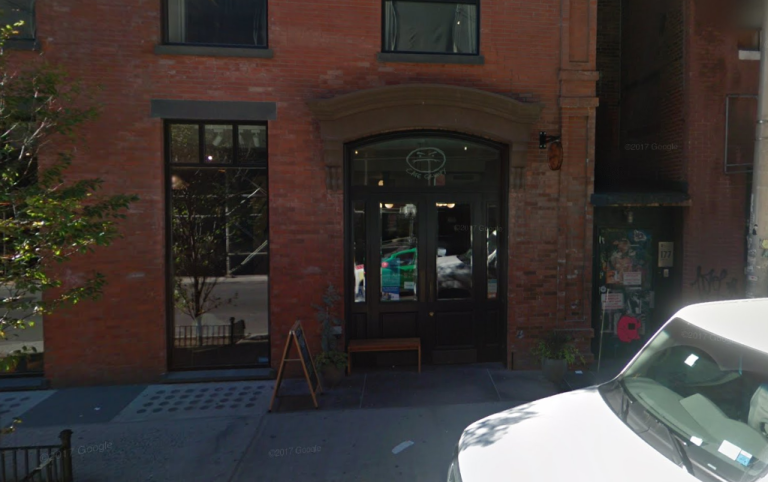
In the middle sixties, traffic exploded and with it the need of business to deliver flat goods efficiently through cities. Flat goods are legal documents, commercial contracts, magazine layouts, film stills/reels, scripts and revisions, architectural drawings etc.
The Eisenhower mushroom cloud of traffic turned speed and proximity into commodities. Messengers needed to carry multiple packages without returning to base. Time off the bike, necessarily needed to be shortened. A huge time saver is the ability to rummage around in a bag without having to take it off.
Frank, owing to changes in the sewing trades, had to be flexible, branching out from working on sails to creating deck gun covers, canvas water balers, and one-off canvas products for special projects. When he first opened Globe Canvas at Wooster and Dykeman, he expanded his expertise to everything from truck tarps, awnings, boat covers, carousel awnings, batting gauge back stops and circus tents. Urban development forced him to move to the 177 Mott basement address which necessitated another change to smaller projects. He did a bag commissioned by the New York Telephone company, single strap, that could be used for delivering telephone books. The purpose was to keep hands free to drop off books.
Chic said that fateful day a kid came in and wanted Frank to custom build a messenger bag, Frank was delighted. He loved those kinds of challenges so he worked with him, getting the dimensions and features right. Frank took the telephone directory bag and had the kid make his modifications. To accommodate architectural drawings, Frank sewed on bottom straps for tubes. Frank gave him the bag, free of charge, and told him to send his friends in if the bag worked out. The pattern was set, not just a bag pattern, but the street-level social innovation of a product. As promised, messengers came in and bought the bag and with those purchases came more modifications and more feedback making Frank’s bag more useful and more popular with every iteration.
Globe Goes West
Call it a stroke of luck, call it fate, but somehow a Globe canvas bag ended up in the hands of Erik Zo, a San Francisco messenger in the early eighties. Erik worked at the bi-coastal US Express which was one of the original messenger companies to buy bags in lots from Frank deMartini. Erik got his first bag, used, from another messenger that used to ride in NYC. For the next few years, he tried unsuccessfully to get a new Globe by sending a messenger bound for NY back there with money. He never actually got a new bag, or his money returned.
Erik had a background in bike racing and bike mechanics. At one point, he was the Northern California/Nevada District Cycling Champion. As I remember him, he was a bit eccentric, a bit erudite with a splash of punk and hippy thrown in. I saw him spank rookie messengers like me and other self-proclaimed bad asses in Alleycats either on some crazy Crankencycle (like Frankenstein, a bicycle built of odd parts) or a cargo bike. It was in his nature to innovate everything to do with bicycles. As one of the first messengers to ride road bikes in San Francisco, he successfully started a revolution converting nearly the entire population of bike messengers from single-speed Schwinns with baskets, to road bikes and messenger bags.
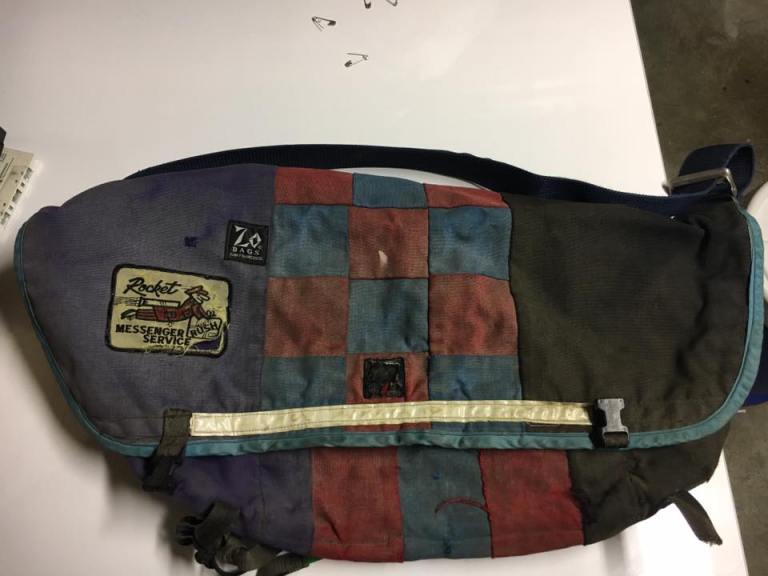
Erik Zo started making messenger bags when his second-hand Globe started falling apart. His girlfriend at the time was making beach shorts and he’d watched his mother sewing all through his youth. He decided to try his hand at creating his own bag, with improvements on the Globe pattern. Zo recalled, “I still wasn’t getting a bag from New York; mine was really bad at this point. I tried to fix it, but her sewing machine just would not do it. So I bought one that would and repaired my bag.”
Erik experimented with patterns, fabrics and buckles. Instead of a single shoulder bag, he made left-handed and right-handed bags. Right out the gate he innovated with Cordura fabric and Fast-ex buckles instead of metal buckles to close the flap. He also used Velcro as an assist in closing the flap. This further increased the speed in using the bag. As soon as his prototype bag hit the streets, it was in hot demand. He kept experimenting with the design, making a single piece bag instead of a sewn-on flap. The more bags he sold the more he modified it to meet the needs of his messenger clientele.
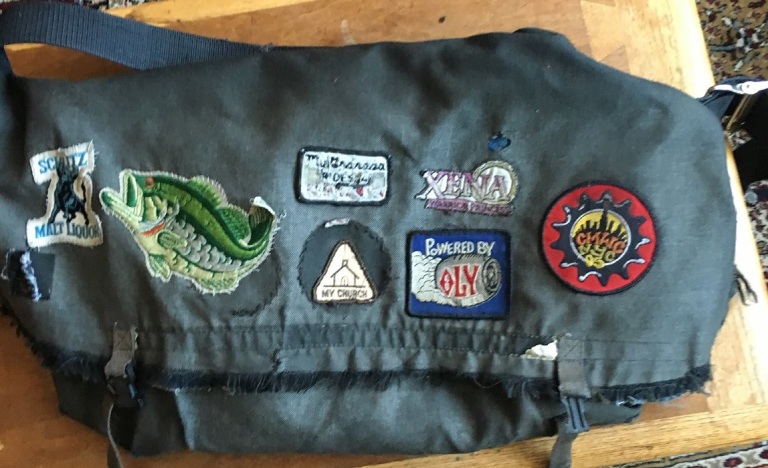
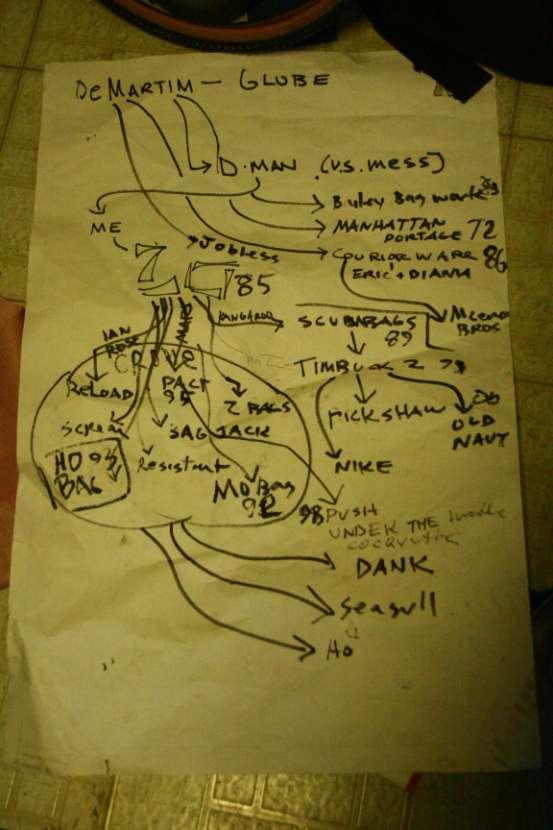
The Dawn of the Mass-Produced Messenger Bag
When the first Globe bags made their way to San Francisco in the eighties, Timbuk2 bags didn’t even exist.
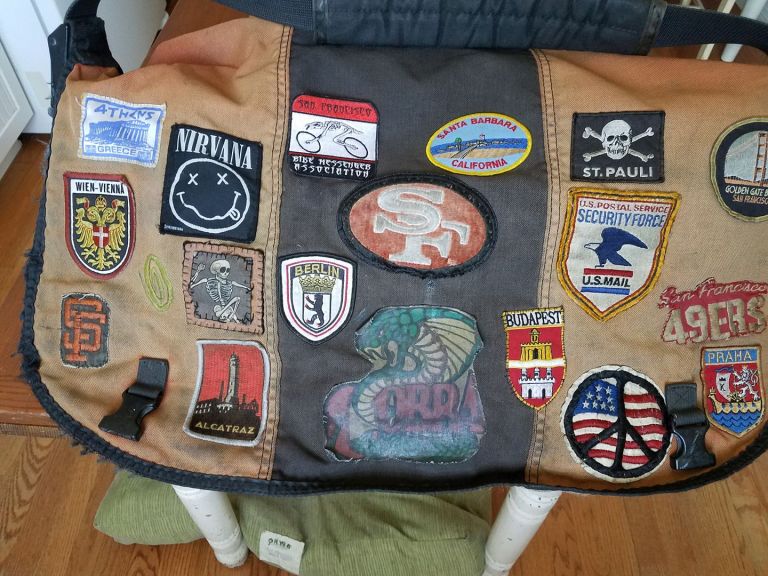
In San Francisco, the Zo Bag was the bag to have. Many San Francisco messengers have complained to me that Globes, after a year of working in SF, were more duct tape than canvas. Around the end of the eighties, Manhattan Portage was making a range of bags from the more expensive lined bags to the flimsy messenger bag that was sold more as an accessory than veritable rough-neck messenger bag that could withstand punishment of daily use. The time was ripe for someone to take advantage of this burgeoning market.
That player came in the form of Scumbags, later known as Timbuk2. Erik basically told me that they stole his design, capitalized on it and marketed the hell out of it. Timbuk2 shot to the top of the messenger bag market in remarkably short order. It was fortuitous for them that Erik Zo was continually innovating his bags and accessories giving them a continual innovation process they didn’t have to finance or put any of their own brain power into. Erik, to this day, is secretive and reclusive only allowing authorized messengers to actually buy his bags, no doubt a reaction to Timbuk2’s bold appropriation. You actually have to earn the right to purchase a Zo Bag.
Timbuk2 Bags became ubiquitous to messenger culture because, to their credit, they adopted the best bag innovations that were out there. They also sponsored messenger events. Most notably they were the title sponsor of the 1996 Cycle Messenger World Championships. Since I was the media liaison for that event, I know we gave them their money’s worth of exposure. Not only did we have THE, Go-to event of the summer, but messengers with their Timbuk2 bags were all over local, national and international media. We were exciting, sexy and those bags looked great on us.
Over the years, Timbuk2 has been a consistent sponsor, appropriate since the Cycle Messenger World Championships gave them the perfect platform to show their wares. Among messengers though, there were strict brand loyalties to local independent bag makers and in organizing of races and other events, we always ensured that the local guys got a crack at sponsorship and bag sales at the events.
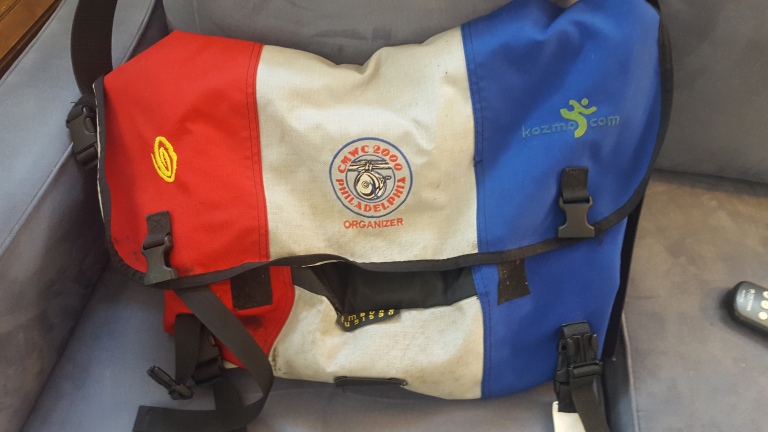
A Community Shares and Grows
Early nineties
Reba Plummer of Toronto, started building bags in the early nineties. She teamed up with Pat from Pac Designs who started making bags when she was injured as a messenger and had to stay home to recuperate. Both former messengers, they opened a combination bag factory and bike store in early nineties. “Pat was an amazing bike mechanic.” They geared up in 1994 in anticipation of the Toronto CMWC in 1996. Though they had a great run, in the end Pat and Reba went their separate ways continuing to make bags on their own, Reba made sure to avoid the proprietary designs Pat had developing, taking special care not to make the lock, waist pouch combination that was the mainstay of Pat’s income.
In Montreal, the first Cocotte was built in 1993 by a bike messenger named Jasmine. She started with a backpack that eventually became a single strap bag. Her and Patric built messenger bags exclusively for messengers until 2000. Companies would buy the bags in lots for their couriers. The problem with building a quality bag though, is that after every one of the 300 messengers in town has a bag, there’s no one left to sell to. So they modified the bag, made it smaller and got it into some small sports stores. Larger stores wouldn’t buy it because they thought it was too expensive.
The Middle 90’s to the present
Joel Metz, a veteran messenger of San Francisco and Portland, knows something of the evolution of messenger bags through his own extensive international travels and contacts. Joel, an organizer of the 1996 Cycle Messenger World Championships, played a huge role in connecting messengers through the internet when it first became accessible to the general public by setting up the website Messengers.org. This utilitarian site, the official site of the International Federation of Cycle Messenger Associations is a veritable clearing house for all things bike messenger.
Joel notes that the though the messenger bag started out as a fundamental tool, it became a part of the messenger’s persona. It became a de facto conveyance of messenger culture, largely through the Cycle Messenger World Championships. The Championships, held around the world for the past 25 years, is one part race, one part entertainment, one part family reunion. Almost a spiritual gathering of this community of individuals, the path of messenger bag development largely follows the person to person connections that could only happen on a large scale at the Championships.
“In 1996, when we had the championships in San Francisco, you either had a Zo or a Timbuk2. Only James Bolger and a few others had Globes, but then they were from NY originally.” Compared with today’s standardized, mass-produced bags, back in the day, “You could tell where a messenger was from by looking at his bag and his bike.” Joel went on to list where the bags were from, and the shifting chronology: “In the early to mid nineties the East Coast was dominated by Manhattan Portage and Courier Ware from Boston. Denver-Boulder couriers had Chrome, Europeans almost universally had Ortliebs or Ortleib knock-offs, Pac Designs and Push the Envelope were from Toronto, Cocotte was from Montreal and Vancouver had Roach Bags.”
Bags were a conversation starter, a way to feel familiar or to demonstrate pride. It was the way of picking out your friends from your city in a teeming throng of hundreds of other messengers at a party. It was a way of networking, finding a place to stay for an upcoming trip, or in some cases, making a trade for something more exotic, a bag that would make you look even more cool because it wasn’t the local brand.
Toward the late nineties Bailey Works supplanted Courier Ware in Boston in terms of quality and cache. Under the Weather popped up in Toronto and R.E. Load exploded on the scene in Philadelphia. Also during this time period came some interesting double/single strap combinations including one that was a sideways version of a backpack. At first glance this Pac Designs model looked like a standard one-strap messenger bag, but was adjustable making it a two-strap bag. The stand-out feature of Roach Bags of this period was a waist strap that though it was two straps, allowed the messenger to swing the bag around. There was also a Pac Design “cross-your-heart” strap design allowing even more options.
Reba kept funding the design and small lot manufacture of Push the Envelope bags through the 2000’s. The bag sold well into the middle 2000’s around the world but with the fall in courier fortunes after 9-11 and the consolidation of the market, the basis for making bags was slowing. Though there was a spurt through the middle 2000’s, when the hipster messenger-style trend dropped off, so did sales.
Nowadays Reba will see her bag from time to time, but much less frequently, “It’s great to see them.” One of the innovations, the no sway strap, keeping the bag positioned on the middle of the back, no matter how a messenger contorts herself while riding, has become an industry standard. So, there is evidence of her design contribution in true messenger bags on the street today. “People sometimes get confused between Pac and Push, thinking sometimes that we’re the same person, but messengers speak very highly of both bags.”
The reality of making some of most versatile and well-constructed bags in the business is that they are labor intensive. “I make like twelve bags a year now, because when I think of ways to cut corners to make making them faster, there’s nothing really, that you can leave out.”
For Cocotte, in the early 2000’s, stores started changing their tune. There was now a demand for the smaller messenger bag. “Traffic got worse, people decided they wanted ride bikes, we made bags for people to use to get to work. Just making a messenger bag was too limiting.” A big factor in Cocotte’s re-positioning for survival was the fact that so many manufacturers were leaving North America and going to China. “We wanted to make it known that you can design a quality bag, manufacture it and use suppliers in North America.” They staked their future on a local focus. It turned out to be a good gamble, “Everyone wanted to support that, retailers wanted to help out with the cause.”
In the 2000-teens, messengering itself has changed a lot. Joel remarks, “I ride a cargo bike mostly, but I still carry a standard single-strap messenger bag.” In spite of all the bag innovations, there is one challenge that may never be solved, Joel explains, “The failing aspect of water proof bags is a wet messenger, and that big hole at the top where you put packages in.” Like any veteran messenger, he’s never met a bag that he didn’t feel 100% certain would keep packages dry. “Any good messenger puts a plastic bag in his bag on a rainy day.”

Scrooge, a 35-year messenger in Washington, D.C., another cargo bike messenger, has many bags. He contends that the Chrome bag made for the now defunct Kozmo Messenger was the best waterproof messenger bag ever. This is a guy who has used Ortleibs from Germany who’s claim to fame is that when closed, can be completely submerged and remain bone dry inside.
The only thing that has given out on the bag was the strap, which he replaced twice. Like so many messenger bags, this one has a little story, “Kozmo was going out of business and Wally (a former messenger and friend), called me and told me they were throwing stuff into the dumpster behind the place in the alley and they had thrown out some bags.”
D.C.’s early messenger bag was called, “Jobless” which was an ironic brand to put on a messenger. Likely, the name “Jobless” prominently displayed on the cover flap of the bag which is visible to all, was a retort to angry motorists who would yell at messengers, “Get a job!” When messengers were a new phenomenon, people often thought we were just playing around in traffic, they didn’t seem to make the connection that we were actually working.
Something of a bag aficionado, Scrooge bought a Pac Designs bag, but is averse to actually using it, “It’s just too good, I don’t want to ruin it.” Since he rides a cargo bike, he uses bags mainly just for his bike tools and he insists on a special pocket on the inside, “I have a pocket that holds my oatmeal raisin cookies, it fits perfect.”
One company’s journey
Roland from R.E. Load Bags in Philadelphia had a Manhattan Portage bag when he was growing up in NYC. He bought it when he was in high school at a Canal Street jeans company for $20. “Back in ’92, only a few people had deMartini bags. The Manhattan Portage had a really cheap bag, no lining, straps, buckles, it wasn’t weather proof.” Nonetheless it lasted him all the way through college.
Roland wanted to work in the bike industry using his engineering degree from Drexel but was having a hard time finding job. He decided to take year to let some inspiration happen and if at the end of a year he hadn’t found a way to make a living the way he wanted to, he was going to get a legitimate engineering job.
Roland’s and Ellie’s journey creating their bag making company is at the heart of why the community of bike messengers fostered a microcosm of economic growth and it also serves as an example of how we can look into a future that is going to demand more creativity and entrepreneurship of the average Joe, just to survive.
Roland met Ellie the co-founder of R.E. Load Bags (Roland and Ellie) when she arrived in Philadelphia by freight train hopping from San Francisco. She had stopped in Philly because it was cheap and friendly. As their friendship developed, Ellie became a bike messenger, and then so did he.
The bike messenger job brought the deficiencies of messenger bags into sharp focus for both of them. She had made her own clothes and they got to talking about wanting a whole new concept for a messenger bag. They took a trip to an old marine fabric supply dealer and charmed him into selling them small lots of the things they needed, then they made their own bags.
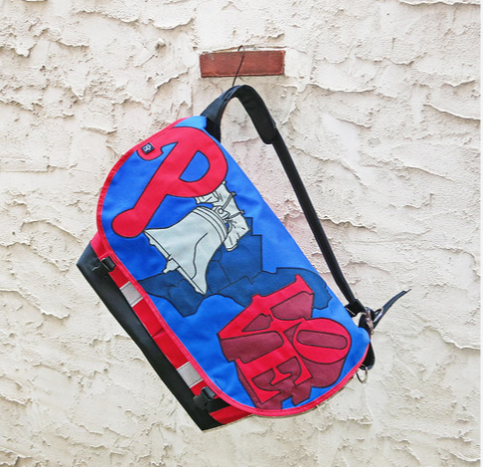
Roland is very humble when he talks about their roll-out and how they were received on the street. The community of Philadelphia was justifiably supportive, the bags were extremely well thought out, designed and made. When Roland and Ellie started doing the East Coast Alleycat circuit, it was explosive. Basically, when the bags hit D.C. when I was there, the only other bags that were more sought after were Pac Designs. R.E. Load Bags weren’t just a messenger’s dream come true as far as being the ultimate utilitarian bag, but they were drop-dead gorgeous. What set them apart were the stunning colorful graphics on the closing flap. Pac Designs did flap graphics as well, but they were simpler patterns. R.E. Load took special orders and did things like the Superman logo and other very special, never repeated requests.
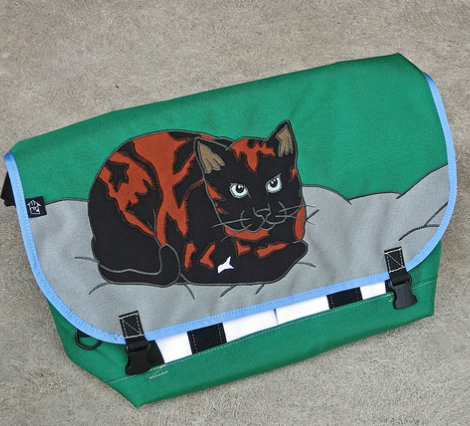
The old man at the fabric supply store got a kick out of them and kept hooking them up. They’d take money in advance for bag orders and then go and request what they needed from the old man, “Let me see about that, come back in a little bit.” They’d come back later between runs.
After a while, they were able to invest about $100 each and buy a semi-industrial sewing machine and move from Roland’s kitchen to a small space in a warehouse. It helped their business development that the guy throwing messenger races in Philly and the fastest messenger in Philly sported the R.E.Load Bag. In very short order, R.E. Load became synonymous with the city itself, at least to the rest of us messengers outside of Philly.

Their big break came when CMWC 2000 was forced to leave Boston and was held in Philadelphia instead. Now messengers worldwide were getting to experience the R.E. Load bag in person. Business was brisk and by the middle of the 2000’s R.E. Load had gone from making 4-5 bags per month to 100 bags a month with 10 full time staff in Philadelphia and 10 in Seattle also stitching.
The problem was that with the increased volume, there was no commensurate increase in margin. The hipster bubble subsided toward the end of the 2000’s and R.E. Load scaled back. “It’s cool to know that we had a big influence on the default standard of making messenger bags,” says Roland. Even though R.E. Load are possibly some of the best made bags on the planet Roland insists that Pac Design bags are the best in the industry. “We met her once, Pat from Toronto, she was cool, she shared some of her suppliers with us, she always had the best innovations, everyone took ideas from her.”

Like the legendary bag maker, Erik Zo, Roland and Ellie took their innovations from the feedback they got from messengers on the street, “We build a bag so that you could take it off the shelf and put it to work, when you get into the mass-production, you can’t really control the details. The guy that answers the phone here is the guy that stitches, the guy that cuts patterns is also putting stuff on the website. Being small helps us stick to our philosophy and make really good bags.

Compared with my shapeless, uncomfortable, difficult to manipulate Timbuk2 which I complain about loudly every time I’m forced to wear it (like when my Cocotte was stolen), using an Artisan Messenger Bag is an exceptional experience because there are decades of experience that go into every stitch. It also helps that bag makers like Roland were actually messengers and understand bag usage intimately.
The end of bike messengers?
9-11 was a particularly hard time for the messenger business. On 9/10/01 there were about 10,000 messengers worldwide. City numbers broke down like this: NYC – 2,000, San Francisco – 500, Toronto – 500, Washington, DC – 500, Los Angeles – 150. By 2005, when I came back to the states on leave from the Marine Corps, I visited those cities and their numbers had declined in some cases by 80%.

Messengering is making a kind of resurgence though. At least in the bigger cities. Nowadays it is big app-based food delivery companies like Deliveroo and Uber Eats that use bike delivery. “These days you have to build bags for food,” explains Roland, “They can be really large in dimensions to accommodate flowers and food.” A lot of the messenger culture still hangs on in the shadow of the flashier branded bike delivery services. As a consequence of even worse working conditions than those of bike messengers of old, there really isn’t a lot of time for socializing and thus building up the social networks like it used to be. The biggest blow to the culture around the messenger bag is the “McDonaldification” of bike delivery. Compelled to wear company gear, a sense of individuality and experimentation has effectively been bred out of the modern-day bike delivery person.

The messenger bag, isn’t just a symbol of our beloved and diminished culture, it is also a talisman reminding us of what creative beings we really are. The bike messenger bag did not exist in the public consciousness, really, until the 1990’s. When the messenger bag shot to fame on the back of Kevin Bacon in “Quicksilver,” messengers were approaching a heyday in culture that will likely never exist again.

Someday, it would be great to have a piece of the Smithsonian Museum dedicated to the American Bike Messenger, and their bags. We’re quickly, as a society, forgetting how to do things and think on our own. Imagination is in extremely short supply. The messenger bag holds amazing quantities of things, extreme weight, and the memory of what it was to live by your wits and be truly alive. We need to hold onto these artifacts of humanity to ground us so human consciousness isn’t swallowed up by an algorithms.



Haha!! Interesting messenger bags with nice stickers.
LikeLike
Nice read, thanks for posting. I’m one of the new breed of Messengers, a Frankenstein combo of Uber, Deliveroo and a lesser known company here in Sydbey, Australia called Yello. The last section makes me a bit sad to hear how the state of things are compared to the earlier years of messenging. There’s hardly any community in the job anymore, when I first started riding a few years ago for Deliveroo there was a bit, we’d all hang out in the park when waiting for deliveries if it wasn’t busy but now that doesn’t even happen. It sucks and a big reason it happens is because 90% of us are international students or on a working holiday visa so they are blow ins of the highest order.
Anyway, I am super glad though that there has been a resurgence at any rate, no matter in what form, because it means i could work on my bicycle and I couldn’t ask for anything more (well except maybe health insurance and a pay rate that reflected the inherent danger of the job!).
LikeLike
Thanks for responding. It makes me sad too that you he state of the industry and how people stil don’t get paid right. Community sometimes has to be made. You’re our community. Nevermind the knuckleheads that don’t hang out and act right. Set the example, get to know some folks and it will spread. If you hve any questions or further thoughts please feel free to reach out. I have a buddy in France, food delivery guy says that the “real ” messengers dont like him. Is that athing in Sydney? I know in my day we were kind of hard on the food delivery guys…
LikeLike
Great read. Makes me really want one of the artisan bags even though I have no real use for one lol. Perhaps one of the smaller ones though that some of them make, like a bit bigger than a fanny pack and still a sling bag over the shoulder or whatever. 🙂 Thank you.
LikeLike
Found this post while attempting to search the WWW for every messenger back company that’s ever existed. The industry, culture, & people are not well documented, so I was delighted when I stumbled upon this post.
Used to be a messenger in Boston, & quit after I was traumatized by a taxi driver on Seaport Blvd. (Which is unfortunate, because, in my experience, cabbies are more aware of & polite to messengers than most motorists.) Anyway, I’ve retained a love & fascination with all the different courier bag designs (both structural & cosmetic aspects), & the companies that makes them.
Really enjoyed the post.
Best wishes.
LikeLike
This is a really good messenger bag history article. Thanks for doing it. I wish I’d seen it sooner. There’s a whole element missing relative to Timbuk2 regarding mass customization and Toyota-style one-piece-flow manufacturing that would have added a lot. I’ve always hoped that what we did to get more bags into the market lifted all boats; opened up opportunities for more bag makers to do more cool/fun stuff.
LikeLike
Perhaps if I get a chance to revise this, I will include this information. Would you mind sharing your email with me so perhaps we could chat about it?
LikeLike
Sure. Sorry I’m so slow to get back to you
LikeLike
Just got an email that you’d posted here again, Lambchop123. I don’t remember if I gave you my email or not. You can contact me at: robhon[at]mac[dot]com
LikeLike
Thanks. I will. Let’s chat
LikeLike
Hi, great article but FYI there’s a link in the ‘Globe Goes West’ paragraph that appears to be hijacked to some NSFW material.
LikeLike